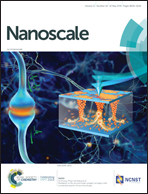The in situ etching assisted synthesis of Pt–Fe–Mn ternary alloys with high-index facets as efficient catalysts for electro-oxidation reactions†
Abstract
Pt-Based alloys enclosed with high-index facets (HIFs) generally show much higher specific catalytic activities than their counterparts with low-index facets in electro-catalytic reactions. However, the exposure of a certain Pt surface would require a well-defined nanostructure, which usually can only be obtained at larger sizes. Therefore, a low dispersion of Pt atoms in Pt-based alloys with HIFs would affect the atomic utilization of Pt, resulting in most of these Pt-based alloys exhibiting lower mass activity than commercial Pt/C and Pt black catalysts for electro-catalytic reactions. Herein, we address a novel strategy to divide the surface areas of larger sized nanocrystals into small surface area nanocrystals by in situ etching Pt–Fe–Mn concave cubes (CNCs) while maintaining the morphology of the Pt–Fe–Mn alloys to improve the utilization of Pt atoms and thus increase the mass activity. Remarkably, the Pt–Fe–Mn unique concave cube (UCNC) nanocrystals (NCs) showed much higher specific and mass activities toward the methanol oxidation reaction (MOR) than the Pt–Fe–Mn CNCs, commercial Pt black and Pt/C. The kinetic analysis from Tafel plots indicated that UCNC Pt–Fe–Mn NCs had the lowest Tafel slope at whole potentials and the splitting of the first C–H bond of a CH3OH molecule with the first electron transfer was the rate-determining step at high potentials (above 0.45 V). In situ Fourier transform infrared reflection (FTIR) spectroscopic investigation at the molecular level indicated that methanol chemical absorption took place at a low potential of −0.2 V at the UCNC NC electrode. Meanwhile, much higher CO2 productivity was observed at the UCNC NC electrode, indicating the strong anti-poisoning ability of the UCNC Pt–Fe–Mn NCs during methanol electrooxidation. Furthermore, in the formic acid oxidation (FAOR) test, the activity and long-term durability of the Pt–Fe–Mn UCNC NCs were also found to be superior to those of the Pt–Fe–Mn CNCs, commercial Pt black and Pt/C. The enhanced catalytic performance in both the MOR and FAOR is most probably due to the unique HIF structure consisting of small sized particles, enhanced Pt utilization, the richness of crystalline defects and synergetic effects of Pt, Fe, and Mn metals. Our present work provides an insight into the rational design of Pt based alloys with HIFs to improve the catalytic performance of electro-catalytic reactions for fundamental study.



 Please wait while we load your content...
Please wait while we load your content...